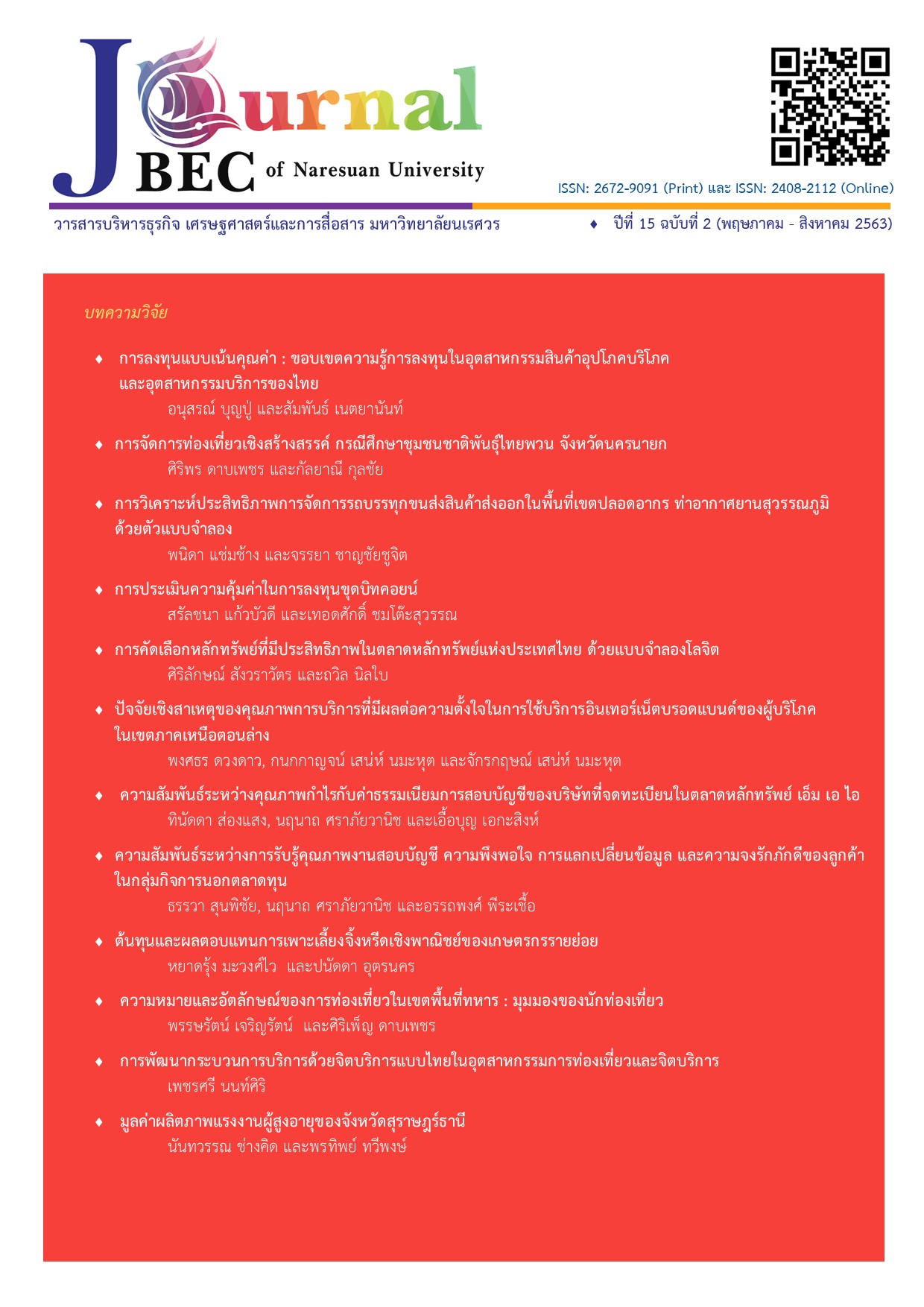ความสัมพันธ์ระหว่างการรับรู้คุณภาพงานสอบบัญชี ความพึงพอใจ การแลกเปลี่ยนข้อมูล และความจงรักภักดีของลูกค้าในกลุ่มกิจการนอกตลาดทุน
Main Article Content
บทคัดย่อ
การวิจัยครั้งนี้มีวัตถุประสงค์เพื่อศึกษาถึง 1) ความสัมพันธ์ระหว่างการรับรู้คุณภาพงานสอบบัญชีและความพึงพอใจของลูกค้า 2) ความสัมพันธ์ระหว่างความพึงพอใจและความจงรักภักดีของลูกค้า 3) ผลกระทบเชิงกำกับของการแลกเปลี่ยนข้อมูลที่มีต่อความสัมพันธ์ระหว่างความพึงพอใจและความจงรักภักดีของลูกค้าในกลุ่มกิจการนอกตลาดทุน เก็บรวบรวมข้อมูลโดยใช้แบบสอบถามจากลูกค้าในกลุ่มกิจการนอกตลาดทุนจำนวน 423 ชุด และนำข้อมูลที่ได้มาวิเคราะห์ผลโดยใช้โมเดลสมการโครงสร้าง
ผลการศึกษาพบว่าการรับรู้คุณภาพงานสอบบัญชีมีความสัมพันธ์ในเชิงบวกต่อความพึงพอใจของลูกค้าอย่างมีนัยสำคัญทางสถิติ และความพึงพอใจของลูกค้ามีผลในเชิงบวกต่อความจงรักภักดีของลูกค้าอย่างมีนัยสำคัญทางสถิติเช่นเดียวกัน นอกจากนี้จากผลการศึกษายังพบว่า สถานการณ์ที่มีการแลกเปลี่ยนข้อมูลต่ำมีผลทำให้ความสัมพันธ์ระหว่างความพึงพอใจของลูกค้าที่มีผลต่อความจงรักภักดีของลูกค้ามากกว่าสถานการณ์ที่มีการแลกเปลี่ยนข้อมูลสูง
คำสำคัญ: 1) การรับรู้คุณภาพงานสอบบัญชี 2) ความพึงพอใจ 3) ความจงรักภักดี 4) การแลกเปลี่ยนข้อมูล 5) กิจการนอกตลาดทุน
Article Details
เอกสารอ้างอิง
Arel, B., Brody, R. G. and Pany, K. (2005). Audit Firm Rotation and Audit Quality. The CPA Journal, 75(1), 36-39.
Beattie, V., Fearnley and Brandt, R. (2000). Behind the Audit Report: A Descriptive Study of Discussions and Negotiations between Auditors and Directors. International Journal of Auditing, 4(2), 177-202.
Beattie, V. and Fearnley, S. (1995). The Importance of Audit Firm Characteristics and the Drivers of Auditor change in UK Listed Companies. Accounting and Business Research, 25(100), 227-239.
Behn, B. K., Carcello, J. V., Hermanson, D. R., & Hermanson, R. H. (1997). The Determinants of Audit Client Satisfaction among Clients of Big 6 Firms. American Accounting Association Accounting Horizons, 11(1), 7-24.
Black, K. (2008). Business Statistics: for Contemporary Decision Making. New York: John Wiley and Sons.
Browne, M. W. and Cudeck, R. (1993). Alternative ways of assessing model fit. Testing Structural Equation Models, 136–162.
Byrne, B. M. (2001). Structural Equation Modelling with AMOS. Basic Concept, Application and Programming. London: Lawrence Erlbaum.
Carcello, J. V., Hermanson, R. H. and McGrath, N. T. (1992). Audit quality attributes: The perceptions of partners, preparers, and financial statement users. A Journal of Practice & Theory, 11(1), 1-15.
Chow, G. C. (1960). Test of equality between sets of coefficients in two linear Regressions. Econometrica, 28(7), 591-605.
DeAngelo, L. E. (1981). Auditor size and audit quality. Journal of Accounting and Economics, 3,183-199.
De Ruyter, K. and Wetzels, M. (1999). Commitment in auditor-client relations: Antecedents and consequences. Accounting Organizations and Society, 24(1), 57-75.
Duff, A. (2004). AUDITQUAL: Dimensions of Audit Quality. Institute of Chartered Accountants of Scotland, Edinburgh.
Duff, A. (2009). Measuring audit quality in an era of change an empirical investigation of UK audit market stakeholders in 20025 and 2005. Managerial Auditing Journal, 24(5), 400-422.
Fontaine, R. and Pilote, C. (2011). An empirical study of Canadian companies to determine clients' preferred relationship approach with their financial auditor. Journal of Marketing Trends, 1(7), 61-69.
Fornell, C. and Larcker, D. F. (1981). Evaluating Structural Equation Models with Unobservable Variables and Measurement Error, Journal of Marketing Research, 18(1), 35-90.
Garrison, R., Noreen, E. and Brewer, P. (2012). Managerial Accounting. Boston: McGraw-Hill.
Hair, J. F., Black, W. C., Babin, B. J., & Anderson, R. E. (2010). Multivariate Data Analysis. (7th ed.), Upper Saddle River, New Jersey: Prentice Hall.
Homburg, C., Giering, A. and Menon, A. (2003). Relationship Characteristics as Moderators of the Satisfaction-Loyalty Link: Findings in a Business-to-Business Context. Journal of Business-to-Business Marketing, 10(3), 35-62.
Hu, L.T. and Bentler, P. M. (1999). Cutoff Criteria for Fit Indexes in Covariance Structure Analysis: Conventional Criteria Versus New Alternatives.Structural Equation Modeling: A Multidisciplinary Journal, 6(1), 1-55.
Iskandar, T. M., Rahmat, M. M. and Ismail, H. (2010). The relationship between audit client satisfaction and audit quality attributes: case of Malaysian listed companies. International Journal of Economics and Management, 4(1), 155-180.
Ismail, I., Haron, H., Ibrahim, D. N., & Isa, S. M. (2006). Service quality, client satisfaction and loyalty towards audit firms Perceptions of Malaysian public listed companies. Managerial Auditing Journal, 21(7), 738-756.
Jones, T. and Taylor, S. (2012), Service loyalty: accounting for social capital, Journal of Services Marketing, 26(1), 60-75.
Kleinman, G., Lin, B. B. and Palmon, D. (2014). Audit Quality A Cross-National Comparison of Audit Regulatory Regimes. Journal of Accounting, Auditing & Finance, 29(1), 61-87.
Lloyd, A. and Luk, S. (2011). Interaction behaviors leading to comfort in the service encounter. Journal of Services Marketing, 25(3), 176-189.
MacCallum, R. C., Browne, M. W., and Sugawara, H. M. (1996). Power Analysis and Determination of Sample Size for Covariance Structure Modeling. Psychological Methods, 1, 130-149.
Marsh, H. W., Hocevar, D. (1985). Application of confirmatory factor analysis to the study of self-concept: First-and higher order factor models and their invariance across groups. Psychological Bulletin, 97, 562-582.
Morton, A. and Scott, D. R. (2007). The Association between Perceived Audit Firm Service Quality and Behavioural Intentions. The Journal of Contemporary Issues in Business and Government, 13(11), 17-30.
Office of Small and Medium Enterprise Promotion (2015). SME Connectivity. 13 April, 2015, http://www.sme.go.th/th/images/data/DA/download/2015/Annual%202015.pdf
Oliver, R. L. (1996). Satisfaction A Behavioral Perspective on the Consumer. New York: McGraw Hill.
Palmer, R. (1989). Account as a mature industry. Journal of Accountancy, 167(5), 84-88.
Pringviriya, N., Hanim, H. F. and Ismail, S. (2015). Service quaility, customer satisfaction and customer loyalty in Thailand’s audit firms. International Journal of Management and Applied Science, 1(5), 34-40.
Sarapaivanich, N. and Patterson, P. G. (2015). The role of interpersonal communication in developing small-medium size enterprise (SME) client loyalty toward an audit firm. International Small Business Journal, 33(8), 882-900.
Sharma, S., Durand, R. M., and Gur-Arie, O. (1981). Identification and analysis of moderator variables. Journal of Marketing Research, 18(3), 291-300.
Sharma, N. and Patterson, P. G. (1999). The Impact of Communication Effectiveness and Service Quality on Relationship commitment in consumer, Professional Services. The Journal of Services Marketing, 13(2), 151-170.
Saxby, C., Ehlen, C. and Koski, T. (2004). Service Quality In Accounting Firms: The Relationship Of Service Quality To Client Satisfaction And Firm/Client Conflict. Journal of Business & Economics Research, 2(11), 75-86.
Shailer, G., Cummings, L., Vatuloka, E., & Welch, S. (2004). Discretionary pricing in a monopolistic audit market. International Journal of Auditting, 8, 263-277.
Sheth, J. and Sobel, J. (2004). Clients for life: how great professionals develop breakthrough relationships. Bangkok: A.R. Business press.
Turk, Z. and Avcilar, M. V. (2009). The effects of Perceived Service Quality of Audit Firms on Satisfaction and Behavioural Intentions: A Research on the Istanbul Stock Exchange Listed Companies. Research Journal of Business Management, 2(1), 36-46.
Yuniarti, R. and Zumara, W. Z. (2013). Audit Quality Attributes and Audit Client Satisfaction. International Journal of Humanities and Management Science (IJHMS), 1(1), 96-100.


